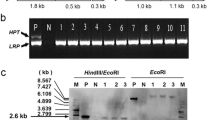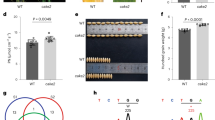Abstract
In plants, lysine catabolism is thought to be controlled by a bifunctional enzyme, lysine ketoglutarate reductase/saccharopine dehydrogenase (LKR/SDH). Lysine is converted to saccharopine, through condensation with α-ketoglutarate, by LKR, and subsequently to glutamate and α-aminoadipate-δ-semialdehyde by SDH. To investigate lysine catabolism in maize kernels, we generated transgenic plants with suppressed LKR/SDH activity in either endosperm or embryo. We found that the suppression of LKR/SDH in endosperm induced an increase in free lysine in developing endosperm, which peaked at 32 days after pollination. At later stages of kernel development, most of the free lysine was found in the embryo along with an elevated level of saccharopine. By combining endosperm LKR/SDH suppression with embryo LKR/SDH suppression through crosses, the saccharopine level in embryo was reduced and resulted in higher lysine accumulation in mature kernels. These results reveal new insights into how free lysine level is regulated and distributed in developing maize kernels and demonstrate the possibility of engineering high lysine corn via the suppression of lysine catabolism.






Similar content being viewed by others
References
Armstrong CL, Rout JR (2001) A novel Agrobacterium-mediated plant transformation method. WO Patent 0109302
Arruda P, Da Silva WJ (1979) Amino acid composition of vascular sap of maize ear peduncle. Phytochemistry 18:409–410. doi:10.1016/S0031-9422(00)81876-2
Arruda P, Kemper EL, Papes F, Leite A (2000) Regulation of lysine catabolism in higher plants. Trends Plant Sci 5:324–330. doi:10.1016/S1360-1385(00)01688-5
Azevedo RA, Damerval C, Landry J, Lea PJ, Bellato CM, Meinhardt LW et al (2003) Regulation of maize lysine metabolism and endosperm protein synthesis by opaque and floury mutations. Eur J Biochem 270:4898–4908. doi:10.1111/j.1432-1033.2003.03890.x
Azevedo RA, Damerval C, Lea PJ, Landry J, Bellato CM, Meinhardt LW et al (2004a) Genetic control of lysine metabolism in maize endosperm mutants. Funct Plant Biol 31:339–348. doi:10.1071/FP03173
Azevedo RA, Lea PJ, Damerval C, Landry J, Bellato CM, Meinhardt LW et al (2004b) Regulation of lysine metabolism and endosperm protein synthesis by the opaque-5 and opaque-7 maize mutations. J Agric Food Chem 52:4865–4871. doi:10.1021/jf035422h
Azevedo RA, Lancien M, Lea PJ (2006) The aspartic acid metabolic pathway, an exciting and essential pathway in plants. Amino Acids 30:143–162. doi:10.1007/s00726-005-0245-2
Belanger FC, Kriz AL (1991) Molecular basis for allelic polymorphism of the maize Globulin-1 gene. Genetics 129:863–872
Brinch-Pedersen H, Galili G, Knudsen S, Holm PB (1996) Engineering of the aspartate family biosynthetic pathway in barley (Hordeum vulgare L.) by transformation with heterologous genes encoding feed-back-insensitive aspartate kinase and dihydrodipicolinate synthase. Plant Mol Biol 32:611–620. doi:10.1007/BF00020202
Coleman CE, Larkins BA (1999) The prolamins of maize. In: Shewry PR, Casey R (eds) Seed proteins. Kluwer Academic Publishers, The Netherlands, pp 109–139
Falco SC, Guida T, Locke M, Mauvais J, Sanders C, Ward RT et al (1995) Transgenic canola and soybean seeds with increased lysine. Biotechnology 13:577–582. doi:10.1038/nbt0695-577
Frizzi A, Huang S, Gilbertson LA, Armstrong TA, Luethy MH, Malvar TM (2008) Modifying lysine biosynthesis and catabolism in corn with a single bifunctional expression/silencing transgene cassette. Plant Biotechnol 6:13–21
Galili G (2004) New insights into the regulation and functional significance of lysine metabolism in plants. Annu Rev Plant Physiol Plant Mol Biol 53:27–43. doi:10.1146/annurev.arplant.53.091401.110929
Heck GR, Chamberlain AK, Ho TH (1993) Barley embryo globulin 1 gene, Beg1: characterization of cDNA, chromosome mapping and regulation of expression. Mol Gen Genet 239:209–218
Hermann T (2003) Industrial production of amino acids by coryneform bacteria. J Biotechnol 104:155–172. doi:10.1016/S0168-1656(03)00149-4
Himber C, Dunoyer P, Moissiard G, Ritzenthaler C, Voinnet O (2003) Transitivity-dependent and -independent cell-to-cell movement of RNA silencing. EMBO J 22:4523–4533. doi:10.1093/emboj/cdg431
Houmard NM, Mainville JL, Bonin CP, Huang S, Luethy MH, Malvar TM (2007) High lysine corn generated by endosperm specific suppression of lysine catabolism using RNAi. Plant Biotechnol 5:605–614. doi:10.1111/j.1467-7652.2007.00265.x
Huang S, Gilbertson LA, Adams TH, Malloy KP, Reisenbigler EK, Birr DH et al (2004) Generation of marker-free transgenic maize by regular two-border Agrobacterium transformation vectors. Transgenic Res 13:451–461. doi:10.1007/s11248-004-1453-3
Huang S, Kruger DE, Frizzi A, D’Ordine RL, Florida CA, Adams WR et al (2005) High lysine corn produced by the combination of enhanced lysine biosynthesis and reduced zein accumulation. Plant Biotechnol 3:555–569. doi:10.1111/j.1467-7652.2005.00146.x
Huang S, Frizzi A, Florida CA, Kruger DE, Luethy MH (2006) High lysine and high tryptophan transgenic maize resulting from the reduction of both 19- and 22-kD α-zeins. Plant Mol Biol 61:525–535. doi:10.1007/s11103-006-0027-6
Karchi H, Shaul O, Galili G (1994) Lysine synthesis and catabolism are coordinately regulated during tobacco seed development. Proc Natl Acad Sci USA 91:2577–2581. doi:10.1073/pnas.91.7.2577
Kemper EL, Cord-Neto G, Papes F, Moraes KCM, Leite A, Arruda P (1999) The role of Opaque2 in the control of lysine-degrading activities in developing maize endosperm. Plant Cell 11:1981–1993
Mazur B, Krebbers E, Tingey S (1999) Gene discovery and product development for grain quality traits. Science 285:372–375. doi:10.1126/science.285.5426.372
Mertz ET, Bates LS, Nelson EZ (1964) Mutant gene that changes protein composition and increases lysine content of maize endosperm. Science 145:279–280. doi:10.1126/science.145.3629.279
Nelson EZ, Mertz ET, Bates LS (1965) Second mutant gene affecting the amino acid pattern of maize endosperm proteins. Science 150:1469–1470. doi:10.1126/science.150.3702.1469
Perl A, Shaul O, Galili G (1992) Regulation of lysine synthesis in transgenic potato plants expressing a bacterial dihydrodipicolinate synthase in their chloroplasts. Plant Mol Biol 19:815–823. doi:10.1007/BF00027077
Shaul O, Galili G (1993) Concerted regulation of lysine and threonine synthesis in tobacco plants expressing bacterial feedback-insensitive aspartate kinase and dihydrodipicolinate synthase. Plant Mol Biol 23:759–768. doi:10.1007/BF00021531
Stepansky A, Less H, Angelovici R, Aharon R, Zhu X, Galili G (2006) Lysine catabolism, an effective versatile regulator of lysine level in plants. Amino Acids 30:121–125. doi:10.1007/s00726-005-0246-1
Tang G, Miron D, Zhu-Shimoni JX, Galili G (1997) Regulation of lysine catabolism through lysine-ketoglutarate reductase and saccharopine dehydrogenase in Arabidopsis. Plant Cell 9:1305–1316
Zhu X, Galili G (2003) Increased lysine synthesis coupled with a knockout of its catabolism synergistically boosts lysine content and also transregulates the metabolism of other amino acids in Arabidopsis seeds. Plant Cell 15:845–853. doi:10.1105/tpc.009647
Zhu X, Galili G (2004) Lysine metabolism is concurrently regulated by synthesis and catabolism in both reproductive and vegetative tissues. Plant Physiol 135:129–136. doi:10.1104/pp.103.037168
Acknowledgements
The authors thank the Monsanto trait development group for the greenhouse and field care, and the Monsanto crop analytic group at St. Louis for the seed composition analysis.
Author information
Authors and Affiliations
Corresponding author
Rights and permissions
About this article
Cite this article
Reyes, A.R., Bonin, C.P., Houmard, N.M. et al. Genetic manipulation of lysine catabolism in maize kernels. Plant Mol Biol 69, 81–89 (2009). https://doi.org/10.1007/s11103-008-9409-2
Received:
Accepted:
Published:
Issue Date:
DOI: https://doi.org/10.1007/s11103-008-9409-2




